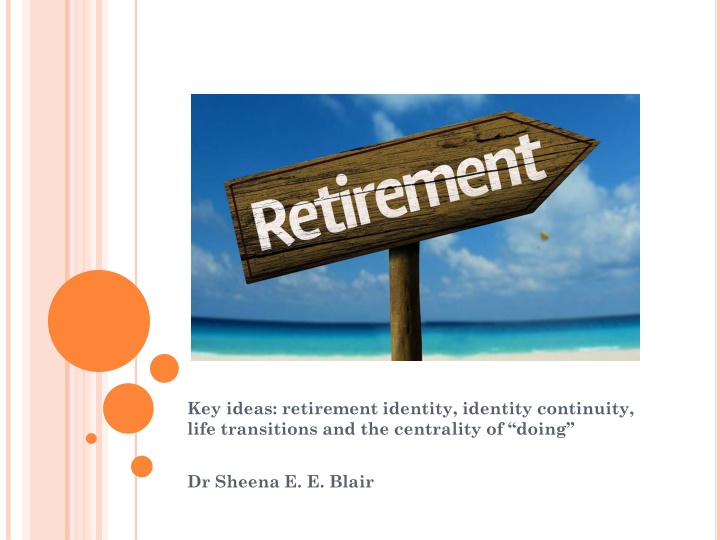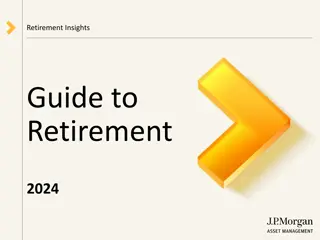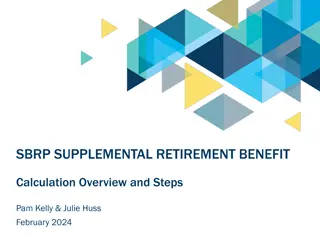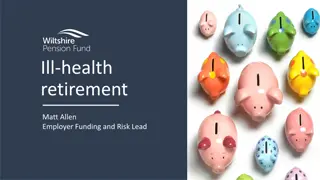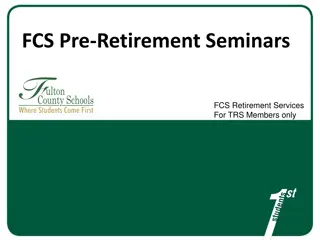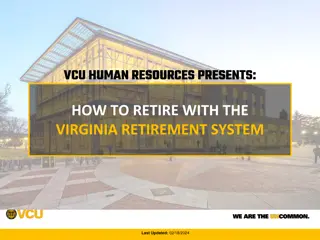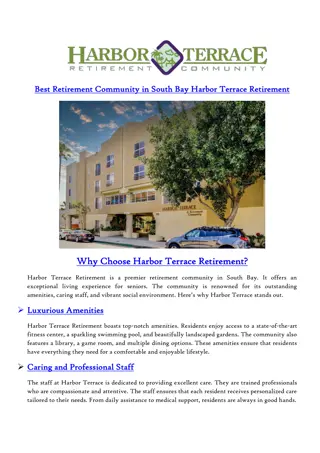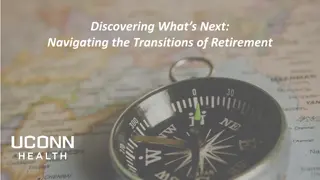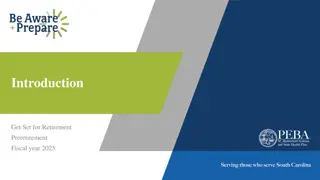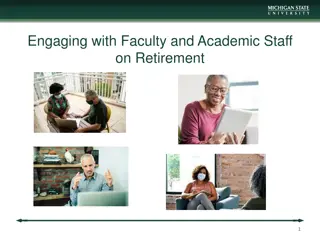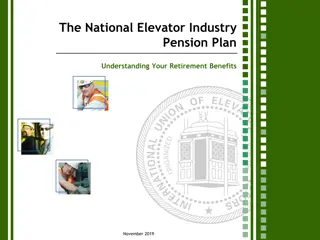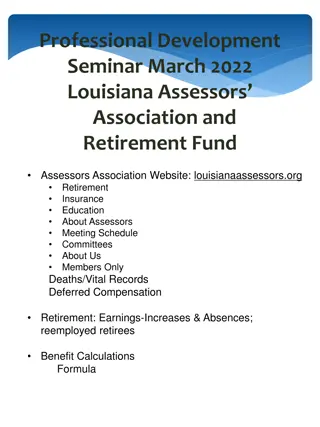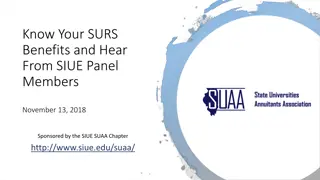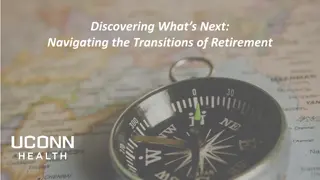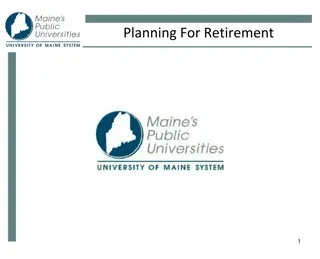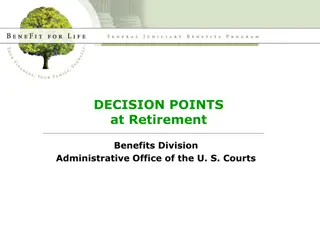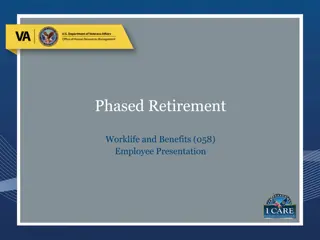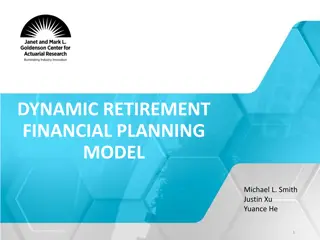Retirement Identity and Life Transitions
Dr. Sheena E. E. Blair discusses retirement identity, identity continuity, and life transitions in this presentation. She emphasizes the centrality of our occupational lives and the psychological aspects of transitioning into retirement, highlighting the importance of reflecting on our identities and roles in this phase of life.
Uploaded on Feb 28, 2025 | 2 Views
Download Presentation

Please find below an Image/Link to download the presentation.
The content on the website is provided AS IS for your information and personal use only. It may not be sold, licensed, or shared on other websites without obtaining consent from the author.If you encounter any issues during the download, it is possible that the publisher has removed the file from their server.
You are allowed to download the files provided on this website for personal or commercial use, subject to the condition that they are used lawfully. All files are the property of their respective owners.
The content on the website is provided AS IS for your information and personal use only. It may not be sold, licensed, or shared on other websites without obtaining consent from the author.
E N D
Presentation Transcript
Key ideas: retirement identity, identity continuity, life transitions and the centrality of doing Dr Sheena E. E. Blair
MY DISCLAIMER My talk is not intended as a blueprint for how to retire or even how to reflect upon retirement That life transition is unique and multi-layered It requires negotiation and re-negotiation with self over time However Prompted by the notion that amongst all the preparations for retirement, the socio- emotional and rethinking of our occupational lives (what we actually do or will do) can be overlooked
THEORETICAL IDEAS WHICH INFORM THE PRESENTATION The Psychology of Life Transitions: how this helps make sense of retirement, identity continuity and can highlight potential resilience factors Ideas from Occupational Science about the centrality of doing in our lives, how this contributes to our identity and life balance
BRIEF PROFILE Age 72, live alone, two children and one grandson Retired occupational therapist and educationalist Been retired from full time post for 12 years and from part time post for 10 years For last ten years I have worked as a freelance educationalist Have ad hoc post as an Assistant Registrar conducting weddings Hobbies include gardening, Pilates, walking, cooking, upcycling, reading and travel
WHAT DO THE LAST TWO SLIDES SAY ABOUT IDENTITY AND CONSTRUCTING IDENTITY? They reveal chosen and valued roles Attempts to negotiate retirement Chosen alternatives to previous work but retaining some key components/traits Key influences in terms of chosen theoretical ideas those which shape thinking Reveals continuity of informing ideas Longstanding fascination with what people do, the form that this takes, the function it occupies but most importantly what it means
IDEAS FROM LIFE TRANSITIONS A life transition has been explained as a discontinuity A transition can have specific characteristics such as whether it is predictable/voluntary It can test our ability to adjust Identity can remain linked (by you and others) to previous important roles ..did you not used to be? Retirement often runs concurrently with other important life transitions concerning for example health, caring responsibilities By the time of retirement, we have successfully negotiated many other transitions and built some resilience
RETIREMENT IS A SIGNIFICANT TRANSITIONAL EVENT Arguably predictable and voluntary Planning for retirement usually occurs but the attention to emotional, social issues and what we will do with more time than we have had in decades can be overlooked Who will we be, what will we do, how will we structure our days, weeks and years It often coincides with other life events such as caring responsibilities, changes in family structure Multiple transition events can strain the ability to adjust
IDEAS FROM LIFE TRANSITIONS We build capacity for adaptation and resilience We strive to achieve a sense of control, continuity and meaningfulness Life transitions impact upon our sense of self, identity and self esteem Need to recognise and acknowledge our stability factors people, ideas, places, faith or objects How to make transitions safe and the idea of transitional objects
HOW DO WE CONSTRUCT OR RECONSTRUCT IDENTITY POST RETIREMENT?
UNDERSTANDING THE PIVOTAL CONTRIBUTION OF OCCUPATION Retirement is an occupational transition New rhythms, patterns, constellations of doing and balance of activity Creating a new sense of self in the process
AN OCCUPATIONAL SCIENTISTS VIEW Form what are the patterns, roles and range of activities characterising our lives Function what are the chosen occupations for self maintenance, leisure, social, creative, spiritual . Meaning what is invested in the chosen occupations. This is the most crucial for reflecting upon our identity and retirement identity
CONCLUDING IDEAS IN WORDS AND PICTURES There is copious literature on key organisational issues of retirement and less upon what it means to retire or how to make sense of a new sense of self and identity Our sense of self and identity is constantly re- framing - especially at the time of a life transition and retirement is a major life transition Ideas from social psychology and occupational science can assist in thinking, re-thinking and sense making of retirement
RETIREMENT CAN BE A TIME FOR AN ENCORE CAREER; FOR TAPPING INTO POTENTIAL; DECOMPRESSING AND JOY MY VIEW IS THAT YOU NEED TIME TO REFLECT UPON AND CONSIDER WHO YOU ARE, WHAT YOU WANT TO DO AND BE
